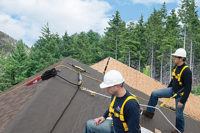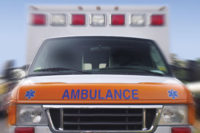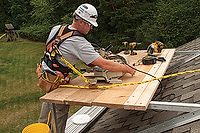Fall Protection

OSHA is about to compile its first revision to the General Industry's fall protection standard (29 CFR, Part 1910) since its initial conception in 1971. In 1990, OSHA published two interdependent proposed revisions to Walking/Working Surfaces standard (1910.21 Subpart D) and Personal Protective Equipment - Fall Protection standard (Subpart I), but has since determined that advances in fall protection technology necessitated reopening the rulemaking process in order to assess various updated consensus standards. A consensus standard is a law that was compiled by soliciting and incorporating public and private commentary and scientifically researched performance and technical standards developed by leaders in a particular field of expertise. The American National Standards Institute is just such a leader.
The agency determined that these standards needed to be simplified and clarified for the end users. For instance, there is currently no PPE standard for personal fall protection systems in Subpart I. These revisions are slated to be applied prospectively to new facilities. There are some indications that there will be a "grandfather clause" installed for facilities that are now in compliance with Subparts D and I. Some have suggested that this revised standard may become too large a document to be practical. In general, Subpart D revisions included provisions for the use of fall protection systems, while Subpart I refers to PPE design and performance criteria.
Upon its eventual enforcement date in the fall of 2004, OSHA will mandate that only General Industry (commercial and industrial) employers comply with this radically revised (1910) consensus standard. When construction employers inevitably enter these same GI facilities in order to perform contract work, they will remain regulated by their own Fall Protection standard (29 CFR Part 1926.500, Subpart M), which will vary dramatically in content, if not intent.
OSHA's regulatory demarcation between industry and construction employers has always been a factor in workplace scenarios, such as contracted mill shutdowns and emergency repairs. At these times, mill maintenance or line employees are found working side-by-side with construction workers in the same environment for weeks at a time. The site conditions and work practices often require completely different work practices in order to remain compliant with the regulations. With the significant differences about to be created by these 1910 revisions, OSHA compliance officers will be mandated to follow the Agency's two different compliance directives to determine separate violations to the two distinct standards. Confusion among employers will undoubtedly follow the future enforcement date. The best defense will include a complete understanding of the revised 1910 Fall Protection Standards.
ANSI's Z359.1-1992 (Reaffirmed in 1999) Accredited Standards Committee (ASC) recently revised its standard entitled "Safety Requirements for Personal Fall Arrest Systems, Subsystems and Components" for the first time since 1992. This technically comprehensive document calls out changes in manufacturing and testing requirements for fall protection equipment. The ASC is submitting its own standard to the Department of Labor for consideration in OSHA's revision of Subpart D (Walking and Working Surfaces) and Subpart I (Personal Protective Equipment). These proposed standards will contain significant changes to the language, definitions, format and content of OSHA's General Industry fall protection standard. Its scope will include: fall protection safe work practices; equipment and systems for climbing, man-riding and work positioning; fall arrest systems; and rescue and evacuation safe work practices.
The American Society of Safety Engineers (ASSE) is the secretariat of this ANSI standard committee, and as the oldest (1911) and largest such society in the world (more than 30,000 members), it carries with it a certain amount of influence. In its comments, the ASSE strongly recommended that OSHA directly cite ANSI Z359.1 in the Final Rule as a source document. They humbly suggest that it is the most current and technically comprehensive body of work on the subject in the world today. The comment period concluded at the end of July 2003 with a collection of commentaries from many national stakeholders. ANSI's comments focused on the several primary sections to the revisions, including:
1. Fall Protection Program (ANSI Z359.0)
This item is meant to establish design and implementation requirements for a managed Fall Protection Program including: a) Site-specific fall hazard assessment techniques b) Elimination or abatement of fall hazards using controls c) Development of rescue and evacuation plans d) Implementation of a Fall Protection/Prevention Training Program
Poor or nonexistent fall protection training is a leading contributor to root-cause fall fatalities and lost-time injuries. All new hires and experienced personnel should receive initial and refresher training in their employer's site-specific Fall Protection Program. ANSI recommends that OSHA reference ANSI Z490.1 ("Criteria for Accepted Practices in Safety, Health and Environmental Training") as it describes the safety and health training materials, instructors and program contents, as well as suggestions for evaluating competent person trainers.
2. Rolling Stock
ANSI's review committee opposed OSHA's exclusion of rolling stock (self-propelled motorized mobile equipment) from coverage under Subpart D. Currently approved for a fall arrestor, body belts used in this equipment may allow the head-first falling worker to fall out of the body belt, create physical constriction of the diaphragm, and cause increased internal pressures due to impact forces.3. Fixed Ladders
Caged ladders should not be considered as alternatives to Personal Fall Protection Systems, as they do not actually arrest a falling worker, but merely redirect the falling body. Items to be considered include: a) The proposed width of the rungs (currently 16-inches minimum) may be reduced to only 12 inches b) May tying off of a PFAS lanyard or positioning device be considered equivalent to a rest platform on extremely high climbs? c) OSHA may propose reducing clearance distances from obstructions while climbing from 16 inches to 12 inches.4. Scaffolds and Controlled Descent Devices
This portion of OSHA's proposed revisions basically defines regulated scaffolds as single and two-point suspension scaffolds; mobile manually propelled scaffolds; and boatswains' chair scaffolds. a) All other types of scaffolds shall be regulated by 1926.450. b) A controlled descent device is similar to a boatswain's chair but it allows a worker to control his descending elevation and stop wherever required to perform vertically dependant tasks. They are typically used for 60 percent of the window washing tasks nationally but are not covered in the standards. c) The eight proposed specific safety requirements are: employee training, equipment inspection, proper rigging, separate fall arrest systems, installation of rigging, rescue procedures, prevention of rope damage, and device stabilization. d) A 300-foot elevation is currently considered the upper safe working limit for controlled-descent devices without additional safety features.5. Anchors for Suspended Work
This is a difficult and often scientific case of engineered material stress analysis vs. the subjective evaluation of the degree of natural or man-made environmental deterioration any structure has incurred over time and use. The current Subpart D does not address the actual installation criteria or maintenance and inspection of these anchor points. a) ANSI proposes that the employer provide, identify the strength of, certify, annually inspect and maintain anchorages. b) Tie-back anchorage points will also be included in the scope of the standard. c) OSHA and ANSI are concerned that the prohibitive cost of inspection and maintenance of suspension anchors may prohibit employers from adequate performance in the future. A delayed effective enforcement date may influence the employer's ability to comply.6. Hierarchy of Fall Protection Controls
The primary control is always the engineering type, such as guardrails. This is often impractical to implement. When guardrails are infeasible, then secondary controls would include: a) PFAS b) Hole covers c) Safety nets OSHA considers that since the Construction Standard has no such hierarchy, it should be deleted from General Industry Standards for uniformity. ANSI strongly recommends installation of hazard control hierarchy in both standards.7. Qualified Climbers
OSHA's definition of a qualified climber is an employee who, by virtue of physical capabilities, training, work experience and job assignment, is authorized by the employer to routinely climb fixed ladders, step bolts or similar climbing devices attached to structures; and in certain limited situations, to climb fixed ladders that are not equipped with fall protection devices. The existing standard provides that fixed ladders more than 20 feet high be equipped with fall protection devices (cages, wells or PFAS systems).
ANSI stated that the recognition of the "qualified climber" should not permit this person to climb structures more than 6 feet without PFAS equipment and training. Climbing extremely high distances (such as stacks and towers) without sufficient protection is never acceptable just because a worker has been designated as "qualified" to do so. Probability and severity of falls for such "extremely elevated" personnel would mandate the highest level of protection, which no amount of "free climbing" training and experience can provide. The criteria OSHA wants the employer to consider when designating a "qualified climber" includes:
a) Number of fixed ladders on the premises: Presumably one ladder is enough to create a potential fall hazard.
b) Number of times a fixed ladder is climbed in a year: OSHA currently recommends no more than two times per year but proposes six times per year. A single "climb" is any work activity at one fixed ladder location that takes place within a 24-hour period, regardless of the number of times the worker ascends/descends.
c) Environmental conditions in which employees should be prohibited from free-climbing: How much rain or ice constitutes a slip hazard? How many miles per hour until winds are too high for worker stability?
d) Providing resting capability for qualified climbers: Employers may be required to provide rest platforms during extremely long continuous climbs (greater than 150 feet) in order to prevent fatigue and endanger the climber.
e) Safe work practices to be used whenever climbing: OSHA currently mandates three-point contact for ladder climbing. PFAS may be required if the worker is carrying tools or equipment with one hand or performing hand-tasks while on a ladder.
f) Providing PFAS during any training exercise. This is a simple safety factor to protect workers who are either inexperienced or untrained until such a time that a CP has evaluated their safe work practices and compliant ladder proficiency and certified them as "Qualified Climbers."
8. Slip Resistance
ANSI agrees with OSHA's proposed inclusion of ASTM F-13 standard's 0.5 slip resistance criteria in this standard as it did in the Steel Erection Standard (1926.750). This ASTM method is a wet-test measurement of traction closely simulating the forces applied by the human foot using a Variable Incidence Tribometer.9. Assisted- and Self-rescue Systems
Here we find criteria for host employers to operate and maintain a viable Fall Rescue Plan; and criteria for construction, use and training required for Fall Protection Rescue Systems. OSHA has always mandated that every employer have an Emergency Action Plan for every elevated PFAS worker. This standard would mandate specific priorities that the employer must employ to protect workers that must be rescued (phase two) from their deployed fall arrest equipment (phase one), including: a) NOT applicable to professional rescue personnel (but always immediately called to respond, can always be canceled) b) All PFAS users designated as potential "rescuers" c) Unassisted self-rescue methods, including controlled descent devices for reaching a lower level; procedures to assess the capability of a fall victim to self-rescue d) Co-worker-assisted rescue methods, where techniques are selected for in-house ascent/descent rescue teams (non-professional), including: High and low-angle rope techniques with back-up safety lines and stand-by personnel Competent Person designated as fall protection rescue trainer Competent Person assigned to design the fall protection rescue plan Methods to recognize and prevent suspension trauma10. Personal Protective Equipment for Fall Protection (Subpart I)
Previously devoid of fall protection coverage, this standard will put forth the design and performance criteria for PFAS in general as well as for specific components of any system. It will mandate that, "The employer shall provide personal protective equipment, including personal fall protection systems, to their employees whenever it is necessary by reason of hazards of processes or environment ... when encountered in a manner capable of causing injury or impairment in function."
OSHA is proposing changes in the standard, including:
a) Trigger height for fall protection to change from 6 feet to 4 feet above a lower level
b) Mandate the employer's "duty" to have fall protection beyond the scope of PFAS
c) Currently, the standard approves the use of body belts for fall protection if the final arresting impact force is limited to 900 pounds. ANSI is opposed to their inclusion in Subpart I due to a variety of other potentially serious hazards:
A victim may fall out of the harness.
Attachment point may shift causing spinal injury.
Internal injuries are likely.
Post-fall positioning may limit physical capability and prohibit self-rescue.
d) Changing the personal fall protection requirements in all of the subparts of the General Industry Standard
Conclusion
While these items that I have selected are not inclusive of all of the proposed regulatory amendments, both OSHA and ANSI have stipulated that these existing and proposed standards apply to General Industry employers only. It doesn't preclude eventual and similar revisions to the Construction Fall Protection Standard (29 CFR Part 1926.500, Subpart M) as well. It has often been the case that the General Industry standards are more frequently reviewed and revised as most of the nation's workforce falls under its regulatory purview. It's also the tendency of the legislature to evaluate the success and/or failure of any health and safety standard by means of assessing the injuries, illnesses, deaths and lost-work-time from the OSHA 300 logs after an appropriate post-enforcement period.Where similar hazardous exposures may occur in the construction industry, Congress will practically consider making the General Industry standard also apply to the Construction industry by way of referencing the 1910 section in the 1926 Subpart. Several examples of "reference standards" already exist in the Construction standard, such as: Hazard Communication (1910.1000), Respiratory Protection (1910.134), Powered Industrial Trucks (1910.178) and Permit-Required Confined Space (1910.146).
Many roofing contractors might consider these changes in the 1910 OSHA law to be "somebody else's problem" when they become the Final Rule sometime in 2004. In fact, they are. However, forewarned is forearmed. For instance, if and when the General Industry Ergonomic Standard is passed into law, it will just be a matter of time until some or all of its requirements are also "referenced" into the Construction Standard. After all, ergonomic injuries comprise the largest set of construction industry Worker's Comp claims, with a greater than 300 percent increase since 1995.
It is just a sound trade practice to watch the birth and evolution of all the safety and health standards conscientiously. Becoming knowledgeable in these standards will probably mean the difference between the successful contractor who prepares for the inevitable legal issues in his future and the struggling contractor who can only react to the extent that time and budget allow. Knowledge is a relatively inexpensive commodity in today's Internet-ready business world. Staying current to the regulations is just a matter of clicking on www.osha.gov and taking a half-hour scan every so often. A heads-up on the regulatory horizon not only protects you from possible citations and insurance losses, but can better protect your valuable personnel from one of the leading cause of workplace injuries: falls from heights.
Looking for a reprint of this article?
From high-res PDFs to custom plaques, order your copy today!






